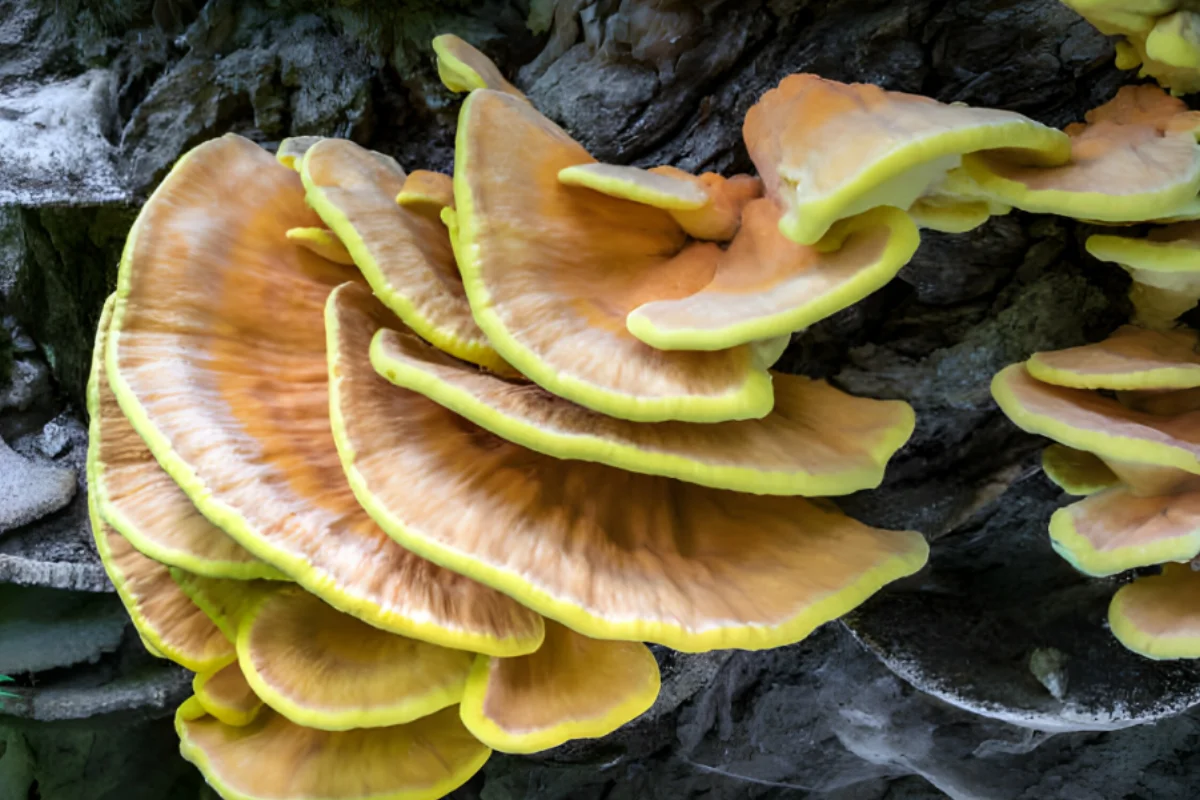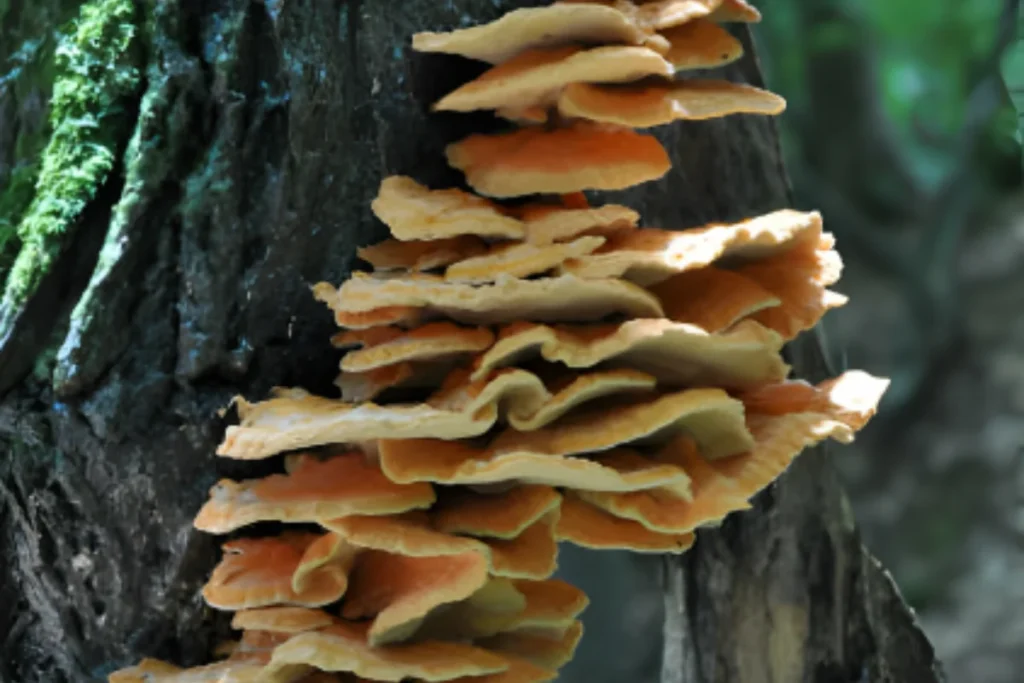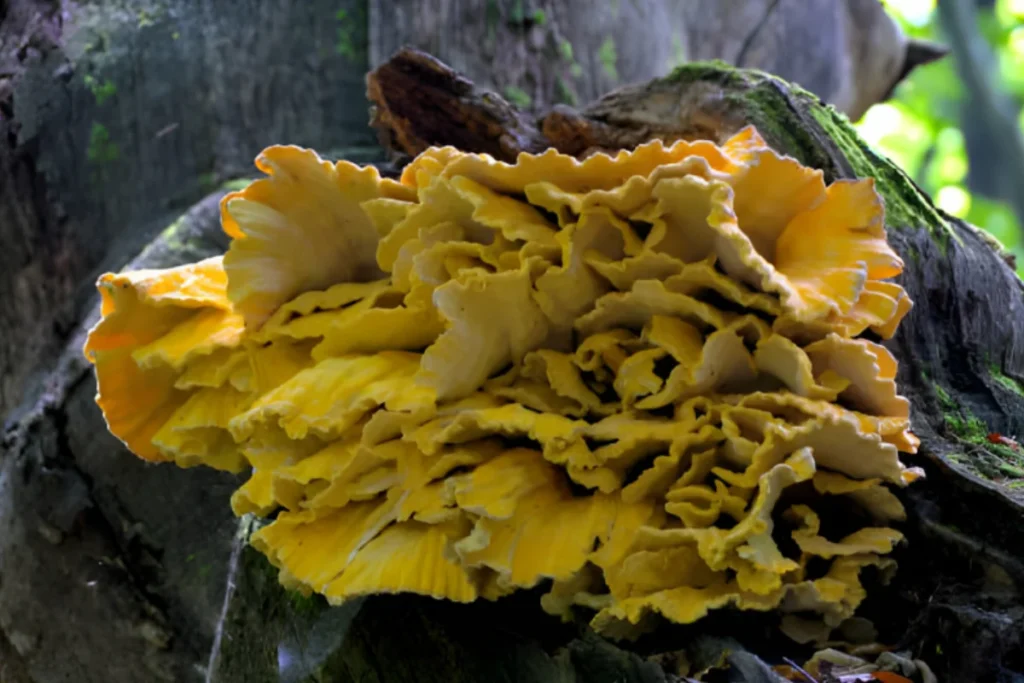Chicken of the Woods, a strikingly vibrant mushroom, captivates both foragers and culinary enthusiasts with its unique characteristics. Unlike the common mushrooms you might find in a grocery store, Chicken of the Woods offers a distinctive experience, both in terms of appearance and taste. This mushroom is not only a feast for the eyes but also a versatile ingredient in the kitchen.
In the realm of edible fungi, Chicken of the Woods stands out for its meaty texture and subtle citrus notes. It’s a favored choice for those seeking a vegetarian or vegan alternative to chicken, thanks to its satisfying chew and flavor profile. For a comprehensive understanding of this fascinating mushroom, A-Z Animals offers a detailed guide that covers everything from identification to culinary uses.
Found primarily on the sides of trees, this mushroom is easily identifiable by its bright orange to yellow hues. It grows in fan-shaped clusters, making it a visually appealing find during foraging expeditions. The Laetiporus genus, to which it belongs, includes several species, but the most common are Laetiporus sulphureus and Laetiporus cincinnatus. Each has its unique characteristics, but both are celebrated for their delicious taste and texture. For those interested in the nuances of mushroom foraging and identification, Fox Farm Forage’s comparison between Chicken of the Woods and real chicken provides insightful information on how to distinguish and prepare these mushrooms.
As a culinary ingredient, Chicken of the Woods is not just a substitute for meat; it’s a star in its own right. Its ability to absorb flavors makes it an excellent addition to a wide range of dishes, from simple sautés to elaborate gourmet recipes.
Understanding Chicken of the Woods
Chicken of the Woods mushrooms, with their vibrant colors and unique texture, offer a culinary adventure unlike any other. This section delves into the physical characteristics, taste profile, and nutritional benefits of these fascinating fungi. For more on foraging and identifying edible mushrooms, check out our guide to foraging mushrooms, which provides essential tips for beginners.
- Physical Characteristics and Identification
- Chicken of the Woods mushrooms are easily recognizable by their bright orange to yellow colors.
- They grow in large, fan-shaped clusters on the sides of trees.
- Unlike many mushrooms, they lack gills, featuring a smooth or slightly wrinkled surface instead.
Understanding these mushrooms goes beyond their striking appearance. Their growth on hardwoods, particularly oaks, signifies their preference for specific environments. This aspect is crucial for foragers and enthusiasts aiming to harvest or simply appreciate these mushrooms in their natural habitat.
-
Taste Profile: Comparing Flavors and Textures
- The texture of Chicken of the Woods is remarkably meaty, offering a satisfying chew.
- Its flavor is subtly lemony, with a hint of chicken, making it a versatile ingredient in various dishes.
The unique taste and texture of Chicken of the Woods make it a sought-after ingredient for both vegetarian and non-vegetarian dishes. Its ability to mimic the taste and texture of chicken allows for creative culinary expressions, from traditional recipes to innovative vegan and vegetarian creations.
- Nutritional Benefits and Culinary Uses
- Chicken of the Woods is not only delicious but also packed with nutrients.
- It provides a good source of protein, fiber, and vitamins, making it a healthy addition to any diet.
Incorporating Chicken of the Woods into meals not only enhances the flavor profile but also contributes to a balanced diet. Its nutritional value, combined with its culinary versatility, makes it a favorite among chefs and home cooks alike.
The understanding of Chicken of the Woods extends beyond its physical attributes to its role in culinary arts and nutrition. This mushroom offers a unique blend of flavor, texture, and health benefits, making it a valuable ingredient in the kitchen. Whether used in simple sautés or elaborate dishes, Chicken of the Woods brings a touch of nature’s bounty to the dining table.
How to Cook Chicken of the Woods
Cooking Chicken of the Woods mushrooms transforms them into a culinary delight. This section explores the best methods to prepare and cook these fungi, ensuring a delicious outcome every time.
- Preparing Chicken of the Woods: Cleaning and Safety Tips
- Always inspect Chicken of the Woods for freshness before cooking.
- Clean them gently with a brush or damp cloth to remove debris.
Safety is paramount when preparing wild mushrooms. Ensure that Chicken of the Woods is properly identified and fresh. Avoid washing them under running water, as they can absorb moisture, affecting their texture when cooked. For those new to cooking with mushrooms, our article on easy and healthy recipes offers insights into preparing and incorporating various mushrooms into your meals.
-
Cooking Methods
- Blanching helps to soften the mushrooms, making them more palatable.
- Frying brings out a crispy texture, perfect for sandwiches or as a side.
- Sautéing in a bit of oil or butter enhances their natural flavors.
- Baking offers a healthier preparation method, retaining the mushrooms’ texture and taste.
Each cooking method brings out different qualities in Chicken of the Woods, from the crispy edges achieved through frying to the tender, juicy texture from baking. Experimenting with these methods can lead to discovering your favorite way to enjoy these mushrooms. For inspiration, explore our collection of delicious recipes, where Chicken of the Woods takes center stage in soups, stews, and even vegan dishes.
- Simple and Gourmet Recipes
- Incorporate into pasta and risotto for a hearty meal.
- Add to soups and stews for depth of flavor.
- Use as a topping for meats or in vegan dishes to add a meaty texture.
Chicken of the Woods mushrooms are incredibly versatile in the kitchen. Their robust texture and subtle flavor make them an excellent meat substitute in vegetarian dishes or a flavorful addition to meat-based recipes. Whether you’re aiming for a simple sauté or a complex gourmet dish, these mushrooms adapt beautifully to various culinary styles.
Cooking Chicken of the Woods is an adventure in flavors and textures. From the initial preparation to the final dish, these mushrooms offer a unique experience for both the cook and the diner. With the right techniques, Chicken of the Woods can elevate any meal, providing a delicious and nutritious option for any occasion.
Advanced Culinary Techniques
Elevating Chicken of the Woods to gourmet levels involves mastering a few advanced culinary techniques. These methods enhance the mushrooms’ natural flavors and textures, making them the highlight of any dish.
- Marinating and Seasoning for Enhanced Flavors
- Marinate Chicken of the Woods to infuse them with bold flavors.
- Experiment with herbs, spices, and acidic components like lemon juice or vinegar.
Marinating not only tenderizes the mushrooms but also introduces complex flavor profiles. Whether aiming for a tangy, spicy, or savory outcome, the right marinade can transform Chicken of the Woods into a mouthwatering ingredient.
- Pairing with Wines and Other Foods
- Select wines that complement the earthy tones of Chicken of the Woods.
- Pair with ingredients that highlight its unique texture and flavor.
Understanding the flavor profile of Chicken of the Woods allows for perfect pairings with wines and other foods. A well-chosen wine can elevate the mushrooms, while complementary ingredients can create a harmonious dish.
- Preservation: Storing Chicken of the Woods
- Store cooked Chicken of the Woods in the refrigerator for short-term use.
- For longer preservation, consider freezing or drying the mushrooms.
Proper preservation ensures that Chicken of the Woods retains its quality and flavor. Whether you’re planning to use them in the near future or saving them for later, these techniques keep the mushrooms ready for your next culinary creation.
Mastering these advanced culinary techniques allows chefs and home cooks to fully explore the potential of Chicken of the Woods. From marinating to pairing and preservation, each step adds depth and complexity to the dishes, showcasing the versatility and deliciousness of these remarkable mushrooms.
Chicken of the Woods vs. Hen of the Woods
While both Chicken of the Woods and Hen of the Woods are popular among foragers and chefs, they differ significantly in appearance, taste, and culinary uses. Understanding these differences is key to utilizing each mushroom to its fullest potential.
- Differences in Appearance
- Chicken of the Woods is known for its bright orange to yellow hues.
- Hen of the Woods presents a more muted, grayish-brown color.
The vibrant color of Chicken of the Woods makes it a standout find in the forest, while the subtler tones of Hen of the Woods blend more with the woodland floor. Each mushroom’s unique appearance aids in its identification and adds visual appeal to dishes.
- Taste and Texture
- Chicken of the Woods offers a meaty texture with a slight lemony taste.
- Hen of the Woods provides a rich, earthy flavor with a tender, flaky texture.
The taste and texture of these mushrooms are distinct, making each suitable for different culinary applications. Chicken of the Woods is often used as a meat substitute, while Hen of the Woods is prized for adding depth to broths and sauces.
- Culinary Uses
- Use Chicken of the Woods in dishes where its robust texture and flavor can shine.
- Incorporate Hen of the Woods into recipes that benefit from its earthy tones and tender texture.
Choosing between Chicken of the Woods and Hen of the Woods depends on the desired outcome of the dish. Each mushroom brings its unique qualities to the table, enhancing recipes with their distinctive flavors and textures.
Understanding the differences between Chicken of the Woods and Hen of the Woods allows for more informed choices in the kitchen, ensuring that each mushroom’s unique characteristics are celebrated in culinary creations.


